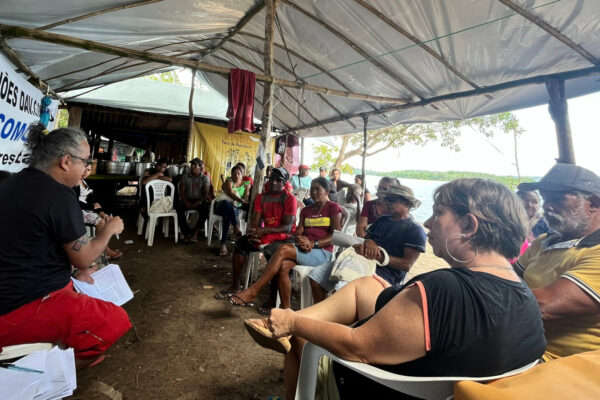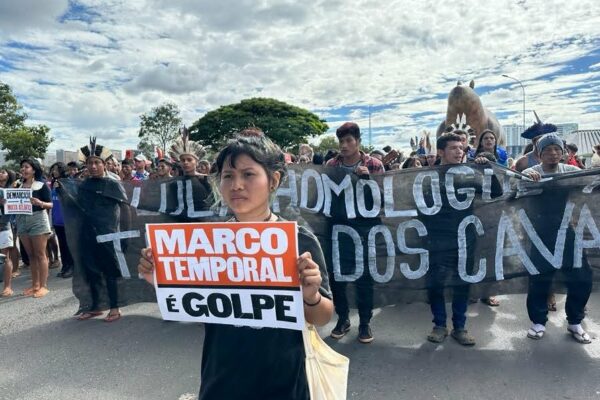Media Backgrounder//Tip-sheet:
Inter-American Development Bank Annual Meeting, Guatemala City, March 16-20
*** Press Conference at 1pm on Friday, March 16. Details Below. ***
Distributed by an alliance of Latin American and US civil society organizations attending the IDB annual meeting
Guatemala City, March 16, 2007 – Executives and directors at the Inter-American Development Bank’s (IDB) 2007 annual meeting are in a race against time – to re-connect the bank’s lending policies with Latin America’s sustainable development needs before the region’s governments dismiss the IDB as irrelevant.
The IDB’s current policies favoring commodity exports and large-scale infrastructure projects are increasingly viewed as antiquated and out of touch with the priorities of most Latin American societies to simultaneously alleviate poverty, protect the environment and reduce sovereign debt. The Bank’s status as the largest source of “development” financing to the region is now in jeopardy; total IDB lending to Latin America has been flat for the past five years at about US$6 billion per annum, and now hydrocarbon-rich countries, such as Mexico, Ecuador, Venezuela and Bolivia, are either pre-paying their existing debts or cutting back on new borrowing. Unless the IDB scores several mega-projects and the region avoids recession, the Corporacion Andina de Fomento (CAF), a sub-regional lender, is expected to soon lend more than the IDB.
The IDB’s supposed commitment to “sustainable development” is being put to the test by the bank’s lending policies. At the IDB’s 2006 annual meeting, for example, Bank President Luis Alberto Moreno, acknowledging the problems with Peru’s hugely-controversial Camisea gas project, made a commitment that no new funding would be available to the project until the multiple problems of Camisea’s first phase were addressed. Yet the IDB has initiated the due diligence process for US$400 million of loans to Camisea’s second phase before an environmental and social audit of the destructive first phase has been completed.
Without a sea-change at the IDB, it will be hard to avoid the conclusion that the bank’s official mandate of “development” has been subordinated to the financing of the extractive industries and the construction of destructive and costly yet politically-expedient infrastructure projects.
IDB RESTRUCTURING
The IDB is currently in the grips of a major institutional shake-up that threatens to undermine its already inadequate environmental and social safeguards.
The restructuring is the response of President Moreno to falling demand within Latin America for IDB loans and support as new national governments turn away from the IDB’s preferred economic prescriptions such as dams, oil and gas drilling, and mining.
Equally, the IDB is facing stiff competition from sub-regional lenders such as the CAF, which has even laxer environmental and social policies. Mr. Moreno’s restructuring, which was approved by the IDB Board on December 1, 2006, will halve the time it takes for loans to be approved, raise the roof on private sector project loans from $75 million to $200 million, and up to $400 million in special cases, and prioritize the biggest infrastructure projects.
The full environmental implications of the restructuring are unclear but one bank official has privately acknowledged that, for Mr. Moreno and his team, the environment is now “at the bottom of the list of priorities”.
THE IDB AND GUATEMALA
The choice of Guatemala as host nation for the IDB’s 2007 annual meeting perfectly highlights the bank’s failure to alleviate poverty, protect the environment and, in short, meet the most basic prerequisites of any “development” policy.
The Bank’s lending to Guatemala over the last 10 years has totaled $1.5 billion and has been aimed at economic development and state reforms, including law enforcement, the tax system, social policies and environmental protection. From almost every perspective, this funding has been disastrous, with no noticeable improvement in living standards for ordinary Guatemalans.
Although not all the ills that rack Guatemala can be laid at the IDB’s door, the Bank clearly needs to do a better job of ensuring good governance in Guatemala, a country with rampant corruption, widespread violence (often still sanctioned or committed by state agents), and urgent environmental issues including the severe overuse of chemical pesticides.
In the period 1993-2003, for example, just 4.2 percent of IDB lending to Guatemala focused on governance while 67 percent was destined for economic growth. Indeed, the IDB’s official evaluation of its country program for Guatemala during this period found that it was possibly the worst supervised program in all Latin America. Unless and until this is rectified, the IDB is highly unlikely to be able to deliver on its promises to improve the lives of ordinary Guatemalans.
CAMISEA
Located in a world biodiversity hotspot, home to some of the last indigenous communities still living in isolation, Peru’s Camisea natural gas project, was intended as a flagship IDB project. Instead, it has become symbolic of the failures of the IDB’s social and environmental policies.
Despite assurances given by IDB President Moreno last year, quoted in the Financial Times, that no new financing would be available to the Camisea consortia until the satisfactory completion of a review of the troubled project’s first phase, the project’s second phase is under construction with “business as usual” bad practices. Civil society groups fear that the audit lacks independence and that the IDB will give Camisea II the green light without adequate scrutiny or any substantive attempt to resolve its major problems.
The impacts of Camisea, which the second phase is likely to spread to huge new areas of Peru’s tropical rainforest and its vulnerable native communities, include erosion, deforestation, an unprecedented five reported pipeline spills and the loss of fish and game on which local indigenous communities depend.
Equally, given that the due diligence process for Camisea II is still under way, even as the project moves ahead on the ground, there is also widespread concern that any social and environmental safeguards that the IDB could impose upon the consortia – a principal justification offered by the Bank for its involvement with the project – would actually be ex post facto and useless in minimizing Camisea II’s anticipated destructive impacts.
IIRSA
The initiative for Integration of Regional Infrastructure in South America (IIRSA by its Spanish and Portuguese acronym) poses one of the greatest challenges to environmental sustainability and social justice today, threatening to industrialize vast areas of the Amazon rainforest and negatively impact local communities.
This IDB-promoted pan-regional “development” blueprint proposes a series of large-scale, high-risk and debt-heavy mega-projects that would result in extensive alterations to landscapes and livelihoods in the region. In this development framework, mountains, forests, and wetlands are seen as barriers to economic development while rivers become the means for extracting natural resources. People, industry, and governments, it is assumed, will all benefit.
Coordinated by all 12 South American governments, IIRSA currently has slated some 40 composite mega-projects and hundreds of smaller, infrastructure improvement projects for potential financing, with a total potential bill of US$37 billion, threatening to ramp up the already unsustainable sovereign debt of many South American nations.
RIO MADEIRA
This IIRSA project envisions the construction of a series of vast dams along the Rio Madeira, the second largest waterway of the Amazon basin – a plan that would have huge impacts on a vast area of primary tropical rainforest.
The Rio Madeira Hydroelectric project is expected to cost at least US$20 billion and to flood a huge area of the Bolivian Amazon. It will impact fragile rainforest and riverine ecosystems downriver and which depend on deposits of the Rio Madeira’s rich sediments, sediments that will be trapped by the dams, eventually threatening to clog their hydroelectric turbines and cut the dams’ power generation capacity.
Equally, by providing a new pathway for soy harvests to reach international markets, the Rio Madeira hydroelectric project will encourage production of Amazonian soy and the massive, climate-changing deforestation that it causes. Environmentalists believe that it will likely lead to the conversion of six million hectares of tropical rainforest to barren land. IBAMA, the Brazilian environmental agency, is set to announce its decision on the project soon.
CONSULTATION AND COMPLIANCE REVIEW MECHANISM
The lack of an adequate channel for the Bank to receive citizens’ complaints about IDB projects and provide justice for adversely-affected communities is arguably the most important procedural issue facing the bank right now. All IDB agencies and projects are subordinate to this mechanism yet it fails to offer basic protections.
Unlike the World Bank’s equivalent complaints procedure, the IDB’s Consultation and Compliance Review Mechanism (CCRM) lacks an independent, transparent and readily accessible process for citizens and others to voice their complaints about Bank projects and, when necessary, either receive compensation or achieve a change in IDB policies and practices.
The current proposed, mechanism, known as the Independent Investigation Mechanism, lacks transparency, provides no support to complainants in what is a difficult and expensive process requiring a team of lawyers and experts, and assumes, unreasonably, that local communities have a good, working knowledge of Bank policies. It also lacks any clear outcomes, with no guarantee that the CCRM’s findings will be made public. Finally, the mechanism offers no recourse when a project is in breach of IDB regulations, instead focusing on negative impacts caused by projects in compliance with the Bank’s regulations.
**************
Media Logistics
A civil society delegation of environmental, sustainable development and human rights groups as well as representative indigenous organizations, drawn from across Latin America and the United States is attending the IDB’s 2007 annual meeting.
For media enquiries, please contact the people mentioned at the top of this press release. Additionally, please feel free to drop by the civil society office in the Centroamericana Room, in the Westin Camino Real Hotel. Press conferences will be held next door, in the El Obelisco Room, of the Westin Camino Real Hotel. Both rooms are on the first floor.
We plan to distribute various press releases during the IDB annual meeting. In addition, we are provisionally planning to hold two press conferences, both in the El Obelisco room. The first press conference will be at 1pm on Friday, March 16. The second press conference will be held at 1pm on Sunday, March 18. Please note: These times could change. Please confirm the press conference times and dates before attending the press conference.













